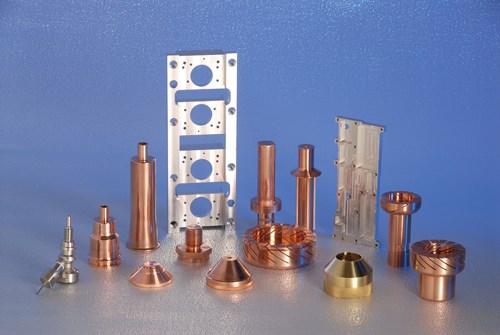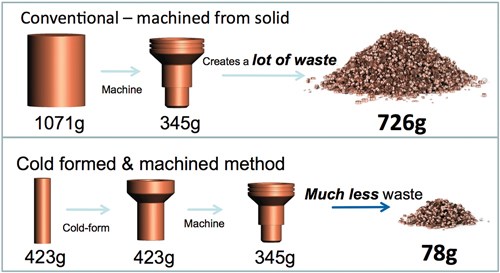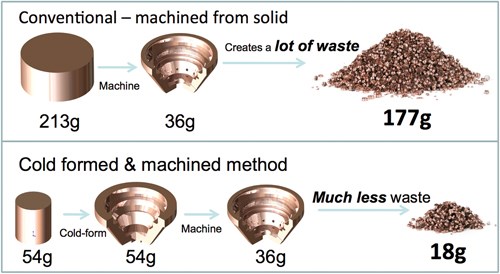The Right Climate for Cold Forming
Today, the cold forming process is capable of delivering precision engineered parts with as much as 80 percent less scrap than machining processes.
Cold forming is a fast, economical way to produce robust, complex components in a range of materials. Because this process originated as a method for producing fasteners during the 19th century, it is still often seen merely as a means of producing simple, high volume components. Therefore, it is commonly overlooked in favor of conventional machining methods for more complex parts.
Today, however, the process is capable of delivering precision engineered parts with as much as 80 percent less scrap than machining processes. Coupled with faster lead times, better surface finish and improved mechanical characteristics, cold forming offers an opportunity for manufacturers across the industry to take advantage of enhanced component quality while also reducing costs.
A Closer Look
As it is performed at ambient temperatures, cold forming can be a considerably faster process than more conventional options, allowing manufacturers to achieve much shorter production times. In turn, components can be made to order extremely quickly, cutting lead times and the need to store high volumes of spare parts on site. Aside from tangible cost savings, cold forming makes for superior quality products by plasticizing metals along their grain boundaries, rather than cutting across. Parts are produced with extremely low levels of stress deformation and high levels of mechanical integrity, resulting in better performance and reliability. Furthermore, cold forming offers outstanding levels of definition, even on parts with complex contours. Typically, dimensional tolerances can be to within plus or minus 2 microns, with the added benefit of extremely fine surface finishes which, in many cases, require no further machining or polishing.
Additionally, parts undergo work hardening during the cold forming process, improving their machinability and durability still further. Work hardening dislocates the structure of the metal in a way that prevents further dislocations, resulting in a stronger component. As this increase in strength is comparable with that of heat treating, it can be more cost effective to cold work a less costly and weaker metal than to hot work a more expensive metal, particularly where a precision finish is required.
The cold forming process also makes it possible to produce component parts with a superior finish, both internally and on the surface. Accurate internal profiles and complex external profiles are possible, enabling precision parts to be manufactured that can have a significant impact on the performance of the equipment in which they are used. Furthermore, there is almost no limit to the shape, size or complexity of the metal components that can be produced using cold forming. Simple cold-headed parts or highly complex cold formed and finish-machined components can be produced for a diverse range of applications.
Cold Forming Stainless Steel
Considerable work has been dedicated to developing a solution that allows stainless steel to be cold formed. As a result, the research and development department at Dawson Shanahan (a UK-based manufacturing and engineering company specializing in precision cold forming and machining) has been able to create and apply a coating and lubrication process that acts as a protective barrier while minimizing friction when each part is formed. The company has had finished parts tested by independent laboratories to confirm that the physical and chemical properties of the stainless steel was retained during the process. Furthermore, the protective barrier prevents galling, thus retaining the desirable surface characteristics of stainless steel.
Because cold forming retains the integrity of the metal while also producing parts with highly polished surfaces and no galling, the performance of a component can be improved dramatically. The derived advantages of this technological process can be of benefit in diverse areas ranging from laser applications (where cold formed nozzles can increase cutting precision significantly) to automotive engine parts such as diesel injectors (where stainless steel can replace copper to enhance the overall reliability of engines and achieve reduced carbon dioxide and particulate emissions, especially where biodiesel is used).
Historically, cold forming in stainless steel has been problematic because of the hardness and unique mechanical properties of the metal. The difficulty is that many of the punch and die sets used in cold forming are also made from stainless steel, so they tended to collapse slightly when first used. However, Dawson Shanahan is developing a complex tooling design to allow for this controlled deformation. This technology can open new opportunities for the manufacture of precision parts in the healthcare sectors, including surgical instruments and equipment.
Taking Advantage of Aluminum
Cold forming can affect the physical characteristics of aluminum and provide a unique surface finish. Cold-formed parts have surface finishes that mirror the smooth condition and dimensions of the dies. Not only does this somewhat “burnished” condition often eliminate the need for secondary finishing, it can also invest parts with the capacity to preserve, for example, gases with zero leakage for a number of years.
Recently, Dawson Shanahan engineered a cold-formed aluminum tube for the purpose of holding nitrogen gas. A minimum pressure needed to be maintained within the chamber for a period of 2 years. A rubber seal contacting the chamber inner surface was used to prevent gas loss. It was therefore critical that the chamber surface was free from scratches, eliminating gas leak paths and, in turn, loss of pressure. Although the drawing specification required a 0.2 Ra radial surface, the process produced results between 0.04 and 0.08 Ra. This case is one of many that demonstrate the potential advantages of various modern methods for processing manufactured aluminum to suit the needs of different applications.
The Continuing Story
The research and development of cold forming continues; in recent years there has been an increasing shift from experience-based development to computer-aided research, facilitating a deeper and more analytical approach to developing the process.
Cold forming continues to present new opportunities across industry, but it should not necessarily be considered as a separate process; it can be allied to other processes in the interest of economy and product quality. Those who may not have given enough thought to cold forming need to consider that, while some configurations, tolerances and/or hybrid designs will always require additional operations, many second-operation processes have been eliminated by the expanded capabilities of cold-forming equipment and tooling.
Finally, cold forming delivers significant ecological benefits compared with processes such as hot forging, where the high level of heat (and, thus, energy) required comes at a price to the environment. Consequently, cold forming can contribute to a lower carbon footprint while enhancing productivity and business performance.
Read Next
Do You Have Single Points of Failure?
Plans need to be in place before a catastrophic event occurs.
Read More5 Aspects of PMTS I Appreciate
The three-day edition of the 2025 Precision Machining Technology Show kicks off at the start of April. I’ll be there, and here are some reasons why.
Read MoreA Tooling Workshop Worth a Visit
Marubeni Citizen-Cincom’s tooling and accessory workshop offers a chance to learn more about ancillary devices that can boost machining efficiency and capability.
Read More














.jpg;maxWidth=300;quality=90)






